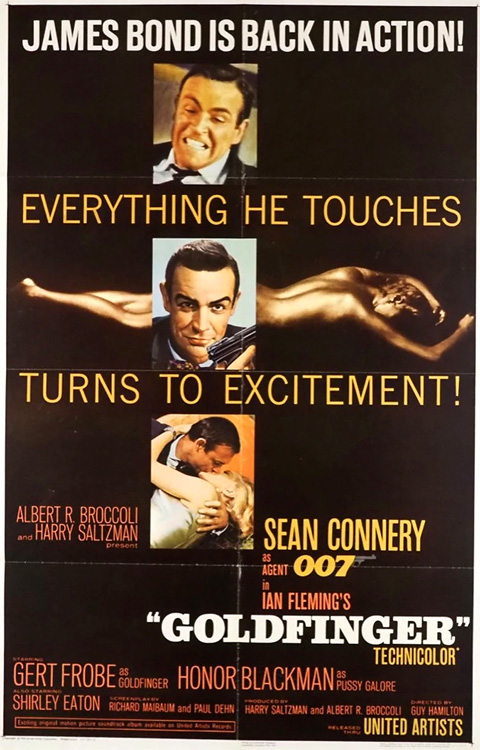“Goldfinger” (1964): The Gold Standard of Bond Films – Film Review

The 1964 film “Goldfinger,” directed by Guy Hamilton, is often celebrated as the quintessential James Bond movie and a defining moment in the 007 franchise. Starring Sean Connery as the suave secret agent, “Goldfinger” set a new standard for the spy genre with its blend of charismatic villainy, innovative gadgetry, and memorable set pieces. This film not only solidified the Bond formula but also left a lasting impact on popular culture.
Narrative and Stylistic Innovations: Elevating the Spy Genre
“Goldfinger” introduces audiences to the formula that would come to define the Bond series: a charismatic and megalomaniacal villain, exotic locations, groundbreaking gadgets, and, of course, the presence of the ‘Bond girl.’ The plot revolves around the titular villain, Auric Goldfinger (Gert Fröbe), and his audacious plan to contaminate the United States Bullion Depository at Fort Knox.
The narrative is tight, fast-paced, and filled with enough twists to keep viewers engaged from start to finish. The script, co-written by Richard Maibaum and Paul Dehn, is sharp and imbued with a sense of fun that was somewhat lacking in the previous Bond films. The film strikes a balance between realism and escapist fantasy, a recipe that would become a hallmark of the Bond franchise.
Behind the Scenes: A Production of Firsts
“Goldfinger” was groundbreaking in terms of its production values and technical achievements. The film’s budget was significantly higher than its predecessors, allowing for more elaborate sets, special effects, and international locations. Ken Adam’s set design, particularly the interior of Fort Knox and Goldfinger’s private jet, was innovative and set a new standard for production design in cinema.
The introduction of the gadget-laden Aston Martin DB5 became one of the most iconic elements of the film. The car was equipped with an array of fictional spy gadgets, including ejector seats and machine guns, which added a new dimension to Bond’s character and served as a precursor to the high-tech gadgets that would populate future Bond films.
Performances: Connery’s Definitive Bond and Frobe’s Iconic Villain
Sean Connery’s portrayal of James Bond in “Goldfinger” is often considered his best. Connery strikes a perfect balance between charm, wit, and ruthlessness, encapsulating the essence of the Bond character. Gert Fröbe, despite his lines being dubbed due to his limited English, delivers a memorable performance as Goldfinger. His portrayal is both menacing and charismatic, creating one of the most memorable villains in the Bond series.
Honor Blackman as Pussy Galore is another standout. She brings a sense of independence and strength to the role, making her one of the most notable Bond girls in the franchise.
Cinematography and Music: Adding Glamour and Suspense
The cinematography by Ted Moore is stylish and sophisticated, capturing the glamour and danger of Bond’s world. The film’s visual style is sleek and polished, with a use of color and lighting that elevates it above standard spy fare.
The music in “Goldfinger,” composed by John Barry, is integral to the film’s success. The title song, performed by Shirley Bassey, is particularly iconic, setting the tone for the film and becoming one of the most recognizable Bond theme songs.
Themes: A Reflection of Cold War Paranoia
“Goldfinger” explores themes relevant to the 1960s, particularly Cold War anxieties. Goldfinger’s plan to attack Fort Knox is a reflection of the era’s fears and uncertainties. The film delves into the world of espionage and high-stakes international conflict, reflecting the geopolitical tensions of the time.
Cultural Impact: Defining the Bond Legacy
“Goldfinger” had a significant impact on the Bond franchise and the spy genre as a whole. Its success established a template that many Bond films would follow and influenced numerous spy movies and TV shows. The film’s blend of action, humor, and sophistication helped to define what audiences would come to expect from a Bond movie.
Final Thoughts
“Goldfinger” is more than just a standout Bond film; it is a cinematic landmark that elevated the spy genre to new heights. Its blend of memorable characters, innovative production design, and cultural relevance make it a classic in the truest sense. The film remains a benchmark against which all subsequent Bond films are measured, a testament to its enduring appeal and significance in the world of cinema.




